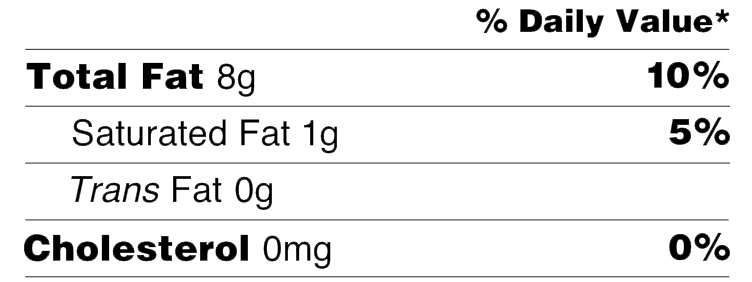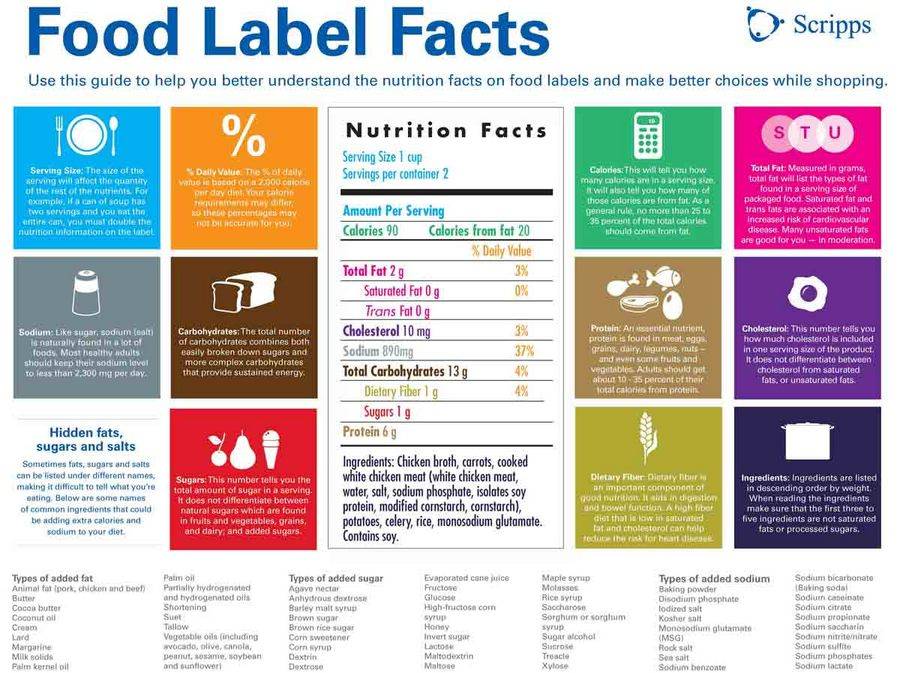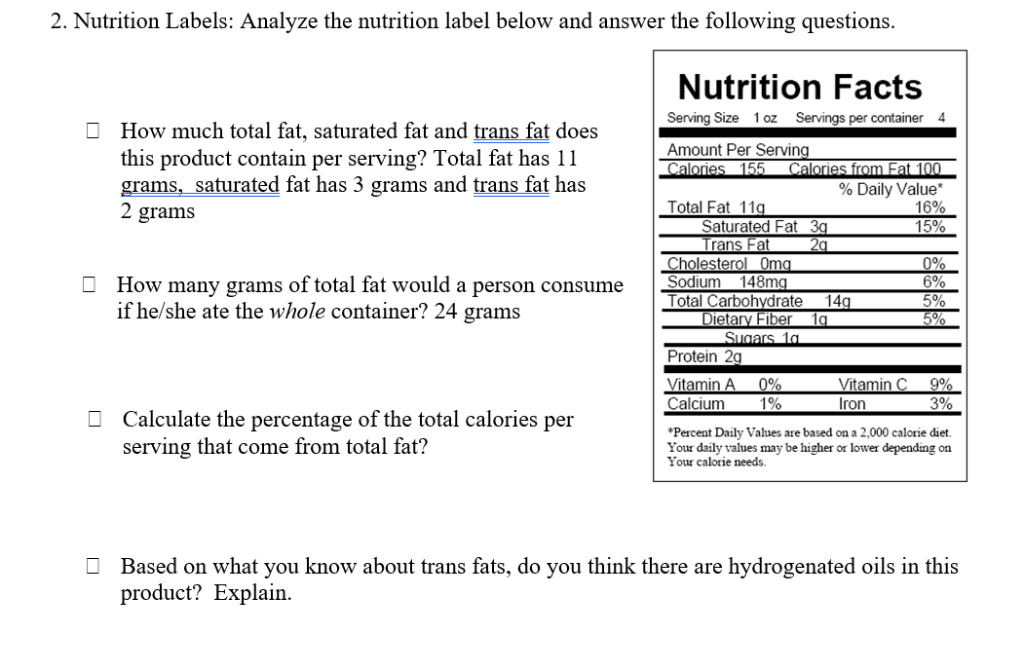38 understanding fat on nutrition labels
Understanding Food Labels | The Nutrition Source | Harvard T.H. Chan ... For example, a bag of potato chips may advertise that it has 40% less fat and is cholesterol-free, suggesting it is a "healthy" food, when in reality even a "healthier" potato chip is still a high-calorie ultra-processed food offering little nutrition. Some terms are not yet regulated by the FDA such as " natural " or "multigrain." Food Labels | CDC Understanding the Nutrition Facts label on food items can help you make healthier choices. The label breaks down the amount of calories, carbs, fat, fiber, protein, and vitamins per serving of the food, making it easier to compare the nutrition of similar products. Be sure to look at different brands of the same foods—nutrition information ...
Nutrition Facts: How to Read Nutrition Labels - Greatist Here are some to look for: Calorie-free: Less than 5 calories per serving. Low calorie: 40 calories or less per serving. Reduced calorie/fat: At least 25 percent less calories/fat than the ...
Understanding fat on nutrition labels
Understanding Food Nutrition Labels | Sanford Fit Vitamin D, potassium, calcium, and iron are listed on the nutrition label as these are nutrients that can often be lacking in a child's food choices. Choose foods that are: Higher in dietary fiber, vitamin D, calcium, iron, and potassium. Lower in saturated fat, sodium, and added sugars. Sugar Content Sugars can be harder to understand. Understanding Nutrition Labels and Information Here is a guide to understanding what those nutritional claims mean: Low Calorie: Less than 40 calories per serving. Calorie Free: Less than 5 calories per serving. Fat-Free: Less than 0.5 grams of fat per serving. Sugar-Free: Less than 0.5 grams of sugar per serving. High Fiber: 5 grams or more of fiber per serving. Food Labels: Fat & Cholesterol | Home & Garden Information Center The Nutrition Facts label shows you how much fat is in a product, even if the fat is hidden as an ingredient. The serving size and the nutrients listed on this label are consistent, which makes it easy to compare similar products without any calculations. % Daily Values (% DVs) are listed in a column on the "Nutrition Facts" label.
Understanding fat on nutrition labels. Tips for understanding the Nutrition Facts Labels Limit fats in your diet to 5%-20% DV for individual food items Aim to have 100% of the % DV of fiber, vitamins, and minerals in your diet—checking labels for the % DV in individual foods can help you achieve that goal Read the label before you eat the food The bottom line The following chart of Percent Daily Values is based on a 2,000-calorie diet. Reading Nutrition Facts Labels | Magaram Center Nutrition Experts Blog Fats Knowing how many calories come from fat per each serving of food is not really useful information since the type of fat consumed is more important than the amount. "Calories from fat" has been removed from the updated nutrition facts label. Labels will continue to include total grams of fat, grams of saturated fat, and grams of trans fat. 20 Tips for Understanding Nutrition Labels | Eat This Not That Keep it Short. Shutterstock. We're talking about ingredients! Keeping the length of an ingredient list to as short as possible will usually make it less likely that you're eating nasty additives. Again, this tip is just a general guide, as some snack bars or nut mixes will contain many good-for-you ingredients. 5. How to understand food nutrition labels | by Alpha Medical Team | Alpha ... The FDA recommends limiting saturated fat, sodium, and added sugars. On the other hand, it's good to get foods that are high in fiber, vitamin D, calcium, iron, and potassium, as these are some...
PDF Interactive Nutrition Facts Label - Understanding and Using the ... Understanding and Using the Nutrition Facts Label 1 Calories 240 Amount per serving Serving size 1 1/2 cup (208g) 4 servings per container Saturated Fat 1.5g the food. % Daily Value* Y Total Fat 4g Trans Fat 0g Cholesterol 5mg Sodium 430mg Total Carbohydrate 46g ... Nutrition Facts Label is based on one serving of the food. 2.5 Understanding Food Labels - Introduction to Nutrition and Wellness The value printed on the Nutrition Facts panel is the percent DV, which tells you how much one serving of the food contributes towards meeting the daily requirement for that nutrient. The FDA uses the following definitions for interpreting the %DV on food labels:4. 5%DV or less means the food is low in a nutrient. Reading and understanding the Nutrition Facts Label for health It is important to direct your attention to the top nutrient section that includes fat, saturated fat, trans fat, cholesterol, sodium and added sugars. These nutrients should be limited. Aim for eating products that have 0 percent trans fat and less than 5 percent saturated fats. Generally 5 percent or less is low and 20 percent or more is high. Interpreting Total Fat and Types of Fat on Food Labels - Nina Cherie ... Now, at the end of the day, since all high-fat foods tend to drive up calorie counts, it's typically recommended that you limit your intake of total fat to 25-35% of your daily calories. Of this amount, saturated fats and trans fats should comprise less than 7-10% and no more than 1%, respectively.
Understanding Nutritional Labels - Beaumont Health Here are the parts of most food labels: Calories (total calories and calories from fat) - This part of the label tells you how many calories each serving has and how many of those calories come from fat. Total Fat - Total fat is the number of fat grams per serving. There are different types of fat. Some are good for you and some aren't. How to Read Nutrition Facts Label - Food Network If you're eating 1600 calories, that equals about 17 grams of saturated fat per day. If you want to go with the American Heart Association's recommendations, that number will be 8.8 grams for the... Understanding Food Nutrition Labels - American Heart Association When the Nutrition Facts label says a food contains "0 g" of trans fat, but includes "partially hydrogenated oil" in the ingredient list, it means the food contains some trans fat, but less than 0.5 grams per serving. So, if you eat more than one serving, you could end up eating too much trans fat. Fat Content on Food Labels - Reading Between the Lines - CyberParent The Mayo Foundation continued, "Still, you may be able to tell if a product contains trans fat, even if it's not directly listed on the food label. Look for the words ' hydrogenated ' or 'partially hydrogenated' in the list of ingredients. These terms indicate that the product contains trans fat.
How to read nutrition labels | safefood Nutrition information can be found on the back/side of food labels. Sometimes you will also find a snapshot of this information on the front of pack. Nutrition information is displayed per 100g and sometimes per recommended serving. Use the per 100g column to compare products. Look at the recommended portion size.
How to understand food labels - Eat For Health Sometimes labels will include nutrition content claims like 'low fat', 'reduced salt' or 'high fibre'. These claims can only be used if the food meets certain criteria. For example, with a 'good source of calcium' claim, the food must contain more than a set amount of calcium. While nutrition content claims can generally guide ...
How to Understand and Use the Nutrition Facts Label | FDA Nutrients to get less of: Saturated Fat, Sodium, and Added Sugars. Saturated fat, sodium, and added sugars are nutrients listed on the label that may be associated with adverse health effects - and...
Get the Facts! Steps to Reading and Understanding Nutrition Facts Labels Steps to Reading and Understanding Nutrition Facts Labels (FN1404, Reviewed Feb. 2022) File. Publication File: FN1404. ... Eating too much saturated fat and/or trans fat, for example, may increase your risk of heart disease. Carbohydrates. Check the amounts of dietary fiber, vitamin D, calcium, iron and potassium.
PDF How Do I Understand the "Nutrition Facts" Label? Nutrition Facts label and ingredient list. When you go grocery shopping, take time to read the Nutrition Facts labels on the foods you purchase. Compare the nutrients and calories in one food to those in another. The information may surprise you. Make sure you aren't buying foods high in calories, saturated fat, trans fat, sodium and added ...
Understanding and Using the Nutrition Facts Label - FDA Nutrition Facts Calories 230 Amount per serving Total Fat Saturated Fat 1g Trans Fat 0g Cholesterol 0mg Sodium Total Carbohydrate 37g Dietary Fiber 4g Total Sugars 12g Includes 10g Added Sugars...
Understanding the Nutrition Facts Label - Know Diabetes by Heart Fats Although fat can also contribute to changes in your blood sugar, they have less influence than carbs. However, it is important to reduce amount of saturated and trans fats as a part of a balanced diet. Replacing foods that are high in saturated fat with healthier options can lower blood cholesterol levels and improve lipid profiles. Sodium
How to Read Nutrition Facts Labels the Right Way - GoodRx Nutrition Facts labels are required to list the total fat, saturated fat, and trans fats on packaged food products. It's important to choose foods with the right kinds of fats. Here are the differences between the fats you'll see on the label. Bad fats Saturated and trans fats are the less healthy types of fats.
Understanding Food Nutrition Labels | American Heart Association When the Nutrition Facts label says a food contains "0 g" of trans fat, but includes "partially hydrogenated oil" in the ingredient list, it means the food contains some trans fat, but less than 0.5 grams per serving. So, if you eat more than one serving, you could end up eating too much trans fat.
Food Labels: Fat & Cholesterol | Home & Garden Information Center The Nutrition Facts label shows you how much fat is in a product, even if the fat is hidden as an ingredient. The serving size and the nutrients listed on this label are consistent, which makes it easy to compare similar products without any calculations. % Daily Values (% DVs) are listed in a column on the "Nutrition Facts" label.
Understanding Nutrition Labels and Information Here is a guide to understanding what those nutritional claims mean: Low Calorie: Less than 40 calories per serving. Calorie Free: Less than 5 calories per serving. Fat-Free: Less than 0.5 grams of fat per serving. Sugar-Free: Less than 0.5 grams of sugar per serving. High Fiber: 5 grams or more of fiber per serving.
Understanding Food Nutrition Labels | Sanford Fit Vitamin D, potassium, calcium, and iron are listed on the nutrition label as these are nutrients that can often be lacking in a child's food choices. Choose foods that are: Higher in dietary fiber, vitamin D, calcium, iron, and potassium. Lower in saturated fat, sodium, and added sugars. Sugar Content Sugars can be harder to understand.









Post a Comment for "38 understanding fat on nutrition labels"